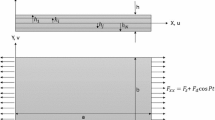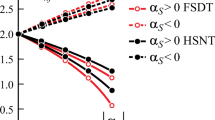Abstract
A higher order shear deformation theory is used to investigate the instability associated with delaminated composite plates subject to dynamic loads. Both transverse shear and rotary inertia effects are taken into account. The procedure is implemented using the finite element method. Delamination is modeled using the penalty parameter approach. The natural frequencies are computed and compared with NASTRAN 3D results and available experimental data. The effect of delamination on the critical buckling load and the first two instability regions is investigated for various loading conditions, plate thickness and boundary conditions. As expected the natural frequencies and the critical buckling load of the delaminated plate are lower than those of the nondelaminated plate. They decrease with increase in delamination length. Increase in delamination length causes instability regions to be shifted to lower parametric resonance frequencies and the normalized width of the instability regions to increase.
Similar content being viewed by others
Author information
Authors and Affiliations
Rights and permissions
About this article
Cite this article
Chattopadhyay, A., Radu, A. & Dragomir-Daescu, D. A higher order plate theory for dynamic stability analysis of delaminated composite plates. Computational Mechanics 26, 302–308 (2000). https://doi.org/10.1007/s004660000174
Issue Date:
DOI: https://doi.org/10.1007/s004660000174




